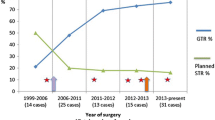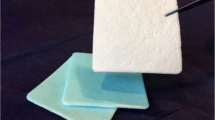Abstract
Cerebrospinal fluid (CSF) leakage is a major complication after extended endonasal transsphenoidal surgery (EETSS), which is commonly used in the treatment of anterior skull base tumors. Dural suturing and graded reconstruction are promising techniques to further decrease the incidence of postoperative CSF (poCSF) leakage. The effect of continuous dural suturing in endoscopic surgery was investigated in this retrospective study. A total of 79 EETSS patients were included; the procedures were performed for subdural tumor removal by a single endoscopic neurosurgical team. Comparisons were applied between patients who did and did not undergo endoscopic dural suturing after tumor removal. Multivariate logistic regression analysis was performed to identify variables that significantly influenced the incidence of poCSF leakage. In all, 79 adult patients developed Esposito’s grade 3 intraoperative high-flow CSF leakage. Ten patients (12.7%) experienced poCSF leakage. One of the 36 patients who underwent intraoperative dural suturing developed poCSF leakage, compared with nine of 43 patients who did not undergo dural suturing (p = 0.016). Regression analysis showed that dural suturing could significantly decrease the incidence of poCSF leakage (p = 0.049, OR 0.108, 95% CI 0.013–0.899). Prophylactic lumbar drainage could also help decrease the CSF leakage rate. Dural suturing under endoscopy is a promising and effective method for application in skull base reconstruction after subdural skull base tumor removal. With future progress, lumbar drainage and even nasoseptal flap placement could be replaced in certain groups of patients undergoing EETSS.


Similar content being viewed by others
References
Bander ED, Singh H, Ogilvie CB, Cusic RC, Pisapia DJ, Tsiouris AJ, Anand VK, Schwartz TH (2018) Endoscopic endonasal versus transcranial approach to tuberculum sellae and planum sphenoidale meningiomas in a similar cohort of patients. J Neurosurg 128:40–48. https://doi.org/10.3171/2016.9.JNS16823
Park HR, Kshettry VR, Farrell CJ, Lee JM, Kim YH, Won TB, Han DH, Do H, Nyguist G, Rosen M, Kim DG, Evans JJ, Paek SH (2017) Clinical outcome after extended endoscopic endonasal resection of craniopharyngiomas: two-institution experience. World Neurosurg 103:465–474. https://doi.org/10.1016/j.wneu.2017.04.047
Wannemuehler TJ, Rubel KE, Hendricks BK, Ting JY, Payner TD, Shah MV, Cohen-Gadol AA (2016) Outcomes in transcranial microsurgery versus extended endoscopic endonasal approach for primary resection of adult craniopharyngiomas. Neurosurg Focus 41(6):E6. https://doi.org/10.3171/2016.9.FOCUS16314
Gardner PA, Kassam AB, Thomas A, Snyderman CH, Carrau RL, Mintz AH, Prevedello DM (2008) Endoscopic endonasal resection of anterior cranial base meningiomas. Neurosurgery 63:36–52; discussion 52-54. https://doi.org/10.1227/01.NEU.0000335069.30319.1E
Hara T, Akutsu H, Yamamoto T, Tanaka S, Takano S, Ishikawa E, Matsuda M, Matsumura A (2015) Cranial base repair using suturing technique combined with a mucosal flap for cerebrospinal fluid leakage during endoscopic endonasal surgery. World Neurosurg 84:1887–1893. https://doi.org/10.1016/j.wneu.2015.08.025
Koutourousiou M, Fernandez-Miranda JC, Stefko ST, Wang EW, Snyderman CH, Gardner PA (2014) Endoscopic endonasal surgery for suprasellar meningiomas: experience with 75 patients. J Neurosurg 120:1326–1339. https://doi.org/10.3171/2014.2.JNS13767
Hadad G, Bassagasteguy L, Carrau RL, Mataza JC, Kassam A, Snyderman CH, Mintz A (2006) A novel reconstructive technique after endoscopic expanded endonasal approaches: vascular pedicle nasoseptal flap. Laryngoscope 116:1882–1886. https://doi.org/10.1097/01.mlg.0000234933.37779.e4
Zwagerman NT, Wang EW, Shin SS, Chang YF, Fernandez-Miranda JC, Snyderman CH, Gardner PA (2018) Does lumbar drainage reduce postoperative cerebrospinal fluid leak after endoscopic endonasal skull base surgery? A prospective, randomized controlled trial. J Neurosurg 1:1–7. https://doi.org/10.3171/2018.4.JNS172447
Ahn JY, Kim SH (2009) A new technique for dural suturing with fascia graft for cerebrospinal fluid leakage in transsphenoidal surgery. Neurosurgery 65(6 Suppl):65–71; discussion 71-72. https://doi.org/10.1227/01.NEU.0000327695.32775.BB
Nishioka H, Izawa H, Ikeda Y, Namatame H, Fukami S, Haraoka J (2009) Dural suturing for repair of cerebrospinal fluid leak in transnasal transsphenoidal surgery. Acta Neurochir 151:1427–1430. https://doi.org/10.1007/s00701-009-0406-2
Esposito F, Dusick JR, Fatemi N, Kelly DF (2007) Graded repair of cranial base defects and cerebrospinal fluid leaks in transsphenoidal surgery. Oper Neurosurg (Hagerstown) 60(4 Suppl 2):295–303; discussion 303-304. https://doi.org/10.1227/01.NEU.0000255354.64077.66
Sakamoto N, Akutsu H, Takano S, Yamamoto T, Matsumura A (2013) Useful “sliding-lock-knot” technique for suturing dural patch to prevent cerebrospinal fluid leakage after extended transsphenoidal surgery. Surg Neurol Int 4:19. https://doi.org/10.4103/2152-7806.107546
Conger A, Zhao F, Wang X, Eisenberg A, Griffiths C, Esposito F, Carrau RL, Barkhoudarian G, Kelly DF (2018) Evolution of the graded repair of CSF leaks and skull base defects in endonasal endoscopic tumor surgery: trends in repair failure and meningitis rates in 509 patients. J Neurosurg 130:861–875. https://doi.org/10.3171/2017.11.JNS172141
Garcia-Navarro V, Anand VK, Schwartz TH (2013) Gasket seal closure for extended endonasal endoscopic skull base surgery: efficacy in a large case series. World Neurosurg 80:563–568. https://doi.org/10.1016/j.wneu.2011.08.034
Chabot JD, Patel CR, Hughes MA, Wang EW, Snyderman CH, Gardner PA, Fernandez-Miranda JC (2018) Nasoseptal flap necrosis: a rare complication of endoscopic endonasal surgery. J Neurosurg 128:1463–1472. https://doi.org/10.3171/2017.2.JNS161582
Alobid I, Enseñat J, Mariño-Sánchez F, de Notaris M, Centellas S, Mullol J, Bernal-Sprekelsen M (2013) Impairment of olfaction and mucociliary clearance after expanded endonasal approach using vascularized septal flap reconstruction for skull base tumors. Neurosurgery 72:540–546. https://doi.org/10.1227/NEU.0b013e318282a535
Albu S, Emanuelli E, Trombitas V, Florian IS (2013) Effectiveness of lumbar drains on recurrence rates in endoscopic surgery of cerebrospinal fluid leaks. Am J Rhinol Allergy 27:e190–e194. https://doi.org/10.2500/ajra.2013.27.3986
Kim EH, Roh TH, Park HH, Moon JH, Hong JB, Kim SH (2015) Direct suture technique of normal gland edge on the incised dura margin to repair the intraoperative cerebrospinal fluid leakage from the arachnoid recess during transsphenoidal pituitary tumor surgery. Neurosurgery 11(Suppl 2):26–31. https://doi.org/10.1227/NEU.0000000000000612
Ishikawa T, Takeuchi K, Nagata Y, Choo J, Kawabata T, Ishizaki T, Wakabayashi T (2018) Three types of dural suturing for closure of CSF leak after endoscopic transsphenoidal surgery. J Neurosurg 1:1–7. https://doi.org/10.3171/2018.4.JNS18366
Author information
Authors and Affiliations
Corresponding author
Ethics declarations
Conflict of interest
The authors declare that they have no conflict of interest.
Ethical considerations
All procedures performed in studies involving human participants were in accordance with the 1964 Declaration of Helsinki and its later amendments or comparable ethical standards and approved by the ethics committee of Beijing Tiantan Hospital.
Informed consent
Consent was obtained from all patients for information collection and analysis.
Additional information
Publisher’s note
Springer Nature remains neutral with regard to jurisdictional claims in published maps and institutional affiliations.
Rights and permissions
About this article
Cite this article
Xue, H., Yang, Z., Liu, J. et al. Continuous dural suturing for closure of grade 3 leaks after tumor removal via an endoscopic endonasal approach. Neurosurg Rev 44, 373–380 (2021). https://doi.org/10.1007/s10143-019-01199-w
Received:
Revised:
Accepted:
Published:
Issue Date:
DOI: https://doi.org/10.1007/s10143-019-01199-w




